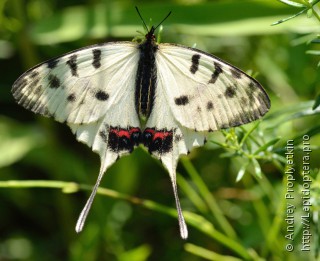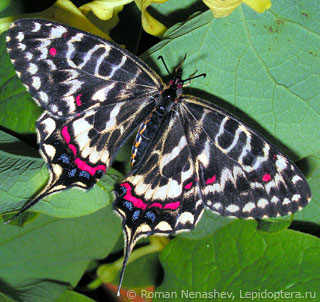Sericinus montela Gray, 1852

Taxonomy
class Insecta → subclass Pterygota → infraclass Neoptera → superorder Holometabola → order Lepidoptera → superfamily Papilionoidea → family Papilionidae → subfamily Zerynthiinae → tribe Sericini → genus Sericinus → species Sericinus montela
Species name(s)
Sericinus montela Gray, 1852 = Sericinus telаmon = Sericinus montelus = Sericinus fortunei Gray 1852 = Sericinus telmona Gray 1852 = Papilio telamon Donovan, 1798 = Sericinus telamon eisneri Bryk, 1932 = Sericinus telamon hoenei Hering, 1935 = Sericinus telamon strandi Bryk, 1913 = Sericinus telamon elegans Bryk, 1913 = Sericinus telamon shantungensis Hering, 1935 = Sericinus telamon hoenei Bryk, 1932 = Sericinus telamon roseni Bryk, 1932 = Sericinus telamon telmonula Bryk, 1932 = Sericinus telamon amurensis Staudinger , 1892 = Sericinus telamon hunanensis Hering, 1935 = Sericinus telamon telemachus Staudinger , 1892 = Sericinus telamon absurdus Bryk, 1913 = Sericinus telamon leechi Rothschild, 1918 = Sericinus telamon fixseni Staudinger , 1892 = Sericinus telamon rudolphi Bryk, 1932 = Sericinus telamon kansuensis Eisner, 1962 = Sericinus telamon koreana Fixsen, 1887 = Sericinus telamon magnus Fruhstorfer, 1913. [3, 9, 187, PC]
Dragon Swallowtail.
urn:lsid:insecta.pro:taxonomy:15100
Expansion
This species marks on the maps: 1.
Zoogeographical regions
Palaearctic.
Russia regions
#40. Primorsky.
Wingspan
50—90 mm.
Primary colors
Red, Yellow, Blue, Brown/Gray/Black.
Flight time
| January | February | March | April | May | June | July | August | September | October | November | December |
Over-wintering stage
Pupa.

Detailed information with references
Taxonomy, synonyms and combinations
- Sericinus telamon. [PC81].
Distribution
- Regions of the Russian Federation: Seaside. [3].
- In Primorye - Rare species with decreasing population. In the southern Primorye are several populations in the October, Ussuri and Shkotovsky areas in the suburbs of Vladivostok. Distribution sericin Amur is local and mosaic character and broadly duplicates the range of host plants caterpillars.It occurs mostly in riparian habitats. Environmentally confined to the dry river valleys malooblesennym areas where locally found on the steep slopes, gullies on the slopes or in river valleys.
Outside the Russian Federation: the North-East and Central China and Korea. In the 80s 20c it has been acclimatized in Japan. [96].
Imago Habitus and Differences from alike species
- For species Sericinus characteristic sharp sexual dimorphism.
Wings top male white with dark brown spots on the hind wings stretched red spot with a dark brown bordering on the leading edge.The rear corner of the rear wings still more elongated red spots with dark brown bordering, outwards from a blue spots - each in dark brown stroke. The underside of the wings with a yellowish tinge, the inner edge of the hind wings is dark. Hind wings with straight caudal appendages, almost equal to the length of the rear wing.In females, coloring the upper side of the wings is dark brown with a dark-yellow dotted wavy narrow strips. On the rear fenders along the outer edge is a row of red spots separated by dark veins, outwards from them - blue spots.The underside of the wings of female narrow yellow bands and a number of bright spots at the outer edges of the rear fenders.
Spring sericin almost half less than year (wingspan can reach 90mm) and differ from year more contrasting pattern and short tails on the hind wings. [95].
General info about Imago
- The males fly slowly but actively overfly the territory of the colony, the female fly is bad flied out to open spaces rarely, usually sitting in the grass and undergrowth kirkazona only sometimes make migration to found new colonies. [96].
Imago lifespan
- During the season - 2 generation pervoe- from mid-May to early June, the second - the beginning of July to mid-August. Sometimes butterflies are found in late August and September
Specific terms of the flight of butterflies spring generation depends on the temperature of spring.
The peak moth flight of summer generation occurs in the second and third decade of July. [100].
General info about Larva
- The duration of the first, second and third instar larvae of sericin is 4 days; fourth stage- 7-8 days, and the fifth to 8 days.
Hatching caterpillars first skeletonizing kirkazona young leaves, and the second age eat around the edges of the sheet.In the younger age groups of caterpillars are always held on the young leaves in older single.
Track last generation pupate on the lower leaf kirkazona as well as leaves and stems of various plants. [100].
Larva food plants / other food objects
- Aristolochia contorta Bunge. - Kirkazon twisted (Prirechny) aristolochiaceae of the family (Aristolochiaceae) [96].
Larva lifespan
Pupa
- Pupa brown with dark spots, lighter males. Pupae from the first generation of larvae in about two weeks give butterflies of the second generation.About half of the "late summer" dolls in a southern Primorye winters, giving the first generation of butterflies in the spring, the second half without diapause gives butterflies optional third generation.
Dolls after curing the adhesive sheets torn Soie easily come off and fall to the ground.Wintering pupae, as opposed nezimuyuschim have on abdominal segments hooked outgrowths-spikes, particularly developed in the last segment.
With outgrowths and rotational movements of the abdomen pupal diapause easy climb under the rug and even a "screwed" into the soil.These "creeping" pupae of butterflies for - a unique case. [100].
Egg
- Eggs are spherical, 0.6-0.7 mm in diameter, at first pale yellow, one day acquire a golden hue, and they appear dark spot near the top; develop 8-9 days. Sericin Females lay eggs in groups of 8-45 pieces (sometimes masonry is to 80-100yaits) on the underside of the leaves and stems kirkazona.The total number of eggs laid by one female, approximately 600-650. [100].
Overwintering stage
- The pupae of the second generation [100].
Subspecies of Sericinus montela
- Sericinus montela amurensis (Staudinger, 1892). [85]
- S. m. hoenei Hering, 1935. [85]
- S. m. hunanensis Hering, 1935. [85]
- S. m. kansuensis Eisner, 1962. [85]
- S. m. koreana Fixen, 1887. [85]
- S. m. leechi Rothschild, 1918. [85]
- S. m. magnus Fruhstorfer, 1913. [9]
- S. m. montela Gray, 1852. [85]
- S. m. shantungensis Hering, 1935. [85]
Authors
Initial species uploading to the site: Peter Khramov.
Photos:
Andrey Proplyetkin, Roman Nenashev. Text data: Peter Khramov, Dmitriy Pozhogin, Irina Nikulina.
The species characteristics formalization: Peter Khramov, Sergei Kotov.
References
- [3] Каталог чешуекрылых (Lepidoptera) России. Под ред. С. Ю. Синёва. СПб.; М.: Товарищество научных изданий КМК, 2008
- [9] Tree of Life (funet.fi), 2012
- [85] Lepidoptera species catalogue, Lepidoptera.ru, 2015
- [95] Животный мир уссурийской тайги. Полевой атлас-определитель животных юга Дальнего Востока России. Владивосток: ИПК «Дальпресс», 2004
- [96] Красная книга Приморского края. http://redbookpk.ru/
- [100] Бовсуновская НН, Глущенко Ю.Н., Мартыненко А.Б. Серицин амурский (Sericinus montela amurensis Stg.) на Дальнем Востоке России Чтения памяти А.И. Куренцова вып XVI 2006г
- [187] Species 2000, http://www.sp2000.org
- [PC81] Dmitriy Pozhogin
Comments
Note: you should have a Insecta.pro account to upload new topics and comments. Please, create an account or log in to add comments

























